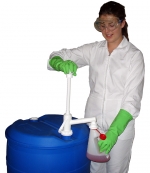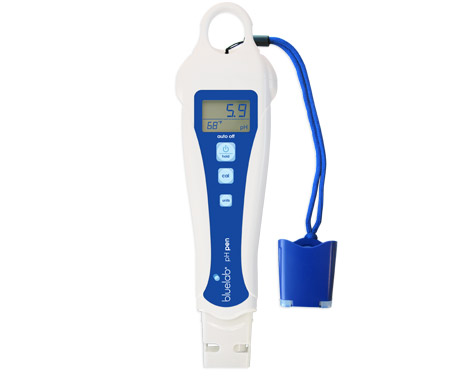The Dangers of Manually Dosing Acid
Manually dosing acid for pH correction is a procedure which can put a crop at risk if done incorrectly.
Overdosing acid is a common occurrence. The effects on the crop are not always immediately seen and can show up a number of days after overdosing has occurred – usually well after the grower has forgotten about the occurrence. Once the pH of a nutrient solution falls much below 3.5 pH the living plant roots it comes in contact with will become burned or removed from the plant. Transpiration and nutrient uptake will immediately be affected and the plant will be put under severe stress. Widespread wilting will be seen and the stressed plant will be at higher risk of disease. The only way the plant can survive is if healthy new roots can grow back to outnumber those that have been damaged or killed off. If the plant is in a warm climate or exposed to wind or direct sunlight then the chances of its survival are reduced because the plant will have a reduced ability to transpire freely to keep cool and to transport nutrients.
There are Five main reasons why pH overdosing occurs.
1) Time
Growers simply do not allow themselves enough time to dose a small amount of acid and allow it to mix in before the tank is retested and the next dose of acid is added. The grower is usually distracted with phone calls or other tasks that need to be done on the farm so they don’t invest the necessary time and focus required for accurate pH dosing.
There is too much temptation to pour in a larger dose of acid to get an immediate pH change, rather than split it into several smaller doses with a decent mixing time allowed in between.
What usually happens is that the pH of the mixing tank drops below 3.5 pH as a result of a larger dose and the pump sucks up the strong solution and sends it out to the crop. The grower retests the tank, notices the pH is well below their desired strength and then they attempt to purge the tank or add fresh water to raise the pH to a safer level.
Or, the larger dose of acid has a localised reaction and lowers the pH of only a small part of the mixing tank solution. The pump still sucks up that low pH solution and sends it out to the crop but shortly after this time the rest of the tank which has a higher pH level, becomes mixed with the lower pH solution and this adjusts the pH level of the whole tank to a more reasonable pH level e.g above 5 pH. The grower thinks that everything is o.k and completes their retesting and dosing before moving on to do other tasks.
In both cases the pH of the nutrient solution has dropped low enough to cause permanent damage to the crop. The plant must then try and recover and will show symptoms of the overdose in the following days.
“Little and often” is the key rule when manually dosing acid.
It is better to dose small amounts of weak acid more frequently throughout the day than large amounts of acid less frequently.
A bucket with a small pin hole in the bottom of it will allow acid to be slowly dripped in over time and be more evenly distributed. This is a safer method than dosing with a jug.
2) The Acid is Too Strong
Full strength acid must be diluted to 5 – 10% strength in a stock solution tank before it is added to a hydroponic mixing tank. If the strength is any any higher than this then the risk of overdosing is greatly increased.
5% = 1 Litre of Full Strength acid to every 20 litres of water in a stock solution tank
10% = 2 Litres of Full Strength acid to every 20 litres of water in a stock solution tank.
Always add acid to water, not water to acid or it will boil and spit acid over the surrounding area.
Always add small amounts of acid and allow sufficient time for retesting before the next dose is added.
Adding stronger acid to a mixing tank does not offer any advantages.
What you will find is that the concentrated glob of acid will sink to the bottom of the tank and only have a localised reaction with the nutrient solution immediately surrounding it. The concentrated glob then has more chance of being sucked up by the pump which usually feeds from the base of the tank. When the concentrated acid only has a localised reaction the grower is more inclined to add more acid to the tank because they are not seeing enough pH change. As a result a higher level of concentrated acid is able to be pumped out to the crop and root damage occurs.
Handling concentrated acid is very dangerous for the grower. Any grower dosing concentrated acid from a full strength container is putting their eyes and skin at risk of severe burns. It only takes one splash of full strength acid in the eyes to cause blindness. A 5 – 10% stock solution should be made with enough volume to last for a few week’s use. The container of concentrated acid should then be stored in a locked cupboard.
Always use a drum pump and safety measure device when decanting acid and wear safety glasses and gloves. You don’t get any second chances when using acid so always ensure you have the right equipment.


www.purehydroponics.com/products/drum-pumps/
Always dilute the acid to 5 – 10% strength and allow enough time for mixing.
3) pH Meter is Not Calibrated.
A pH Meter needs to have the probe regularly cleaned and calibrated in order to maintain accuracy. A dirty pH probe or one which is not calibrated will give a false pH reading. This can easily lead to the grower adding more acid than they need to. The grower thinks they are dosing at the correct strength but the actual pH reading could be much lower than this. Always use pH 4 and 7 calibration solutions to check the accuracy of your pH meter and calibrate the meter on a regular basis.
Never calibrate a dirty pH probe. Always ensure the probe is clean before starting the calibration procedure.
Never use another pH meter as a measure of accuracy. It could be faulty or giving a false reading.
Testing a pH meter in pH 4 and pH 7 calibration solution is the only true measure of accuracy.
4) Insufficient Agitation in the Tank.
If acid is added to a mixing tank and there is insufficient agitation in the tank then you will get pockets of low and high pH readings. Some areas of the tank will give a very low pH reading, other areas will be in the mid range and others will be at a higher level. The tank needs to be thoroughly agitated at the time of dosing to get a uniform pH reading. The use of a venturi oxygenator or a mixing bypass on the pump is recommended or a grower can install an airpump and airstone to pump fresh oxygen bubbles into the tank to aerate and mix it. These devices can run all the time to oxygenate the nutrient solution or they can be activated only when nutrient and pH dosing is being done.
5) Impractical pH Measuring Device
If a grower is manually dosing a large tank or a tank which has limited access to the top of it then it can be impractical using a small handheld pH meter with a built in pH probe for pH measurement. The pH meter simply does not have enough capacity to measure the full volume of the tank solution. pH meters with a detachable probe on a long cable (e.g Bluelab pH Meter) are adequate for larger tanks as this allows the probe to be dropped to a good depth in the tank and moved throughout the tank solution to detect any pockets.
www.purehydroponics.com/products/bluelab-electronic-test-control-products/bluelab-ph-meter/
Small handheld meters with an inbuilt probe (e.g Bluelab pH Pen) are ideal for small tanks but are not ideal for larger tanks as you don’t get the same amount of coverage to detect any pockets of variable pH readings in the larger tank solution.

www.purehydroponics.com/products/bluelab-electronic-test-control-products/bluelab-ph-pen/
For manually dosing pH and nutrients we always recommend the use of a monitor such as a Bluelab Guardian Monitor. This unit gives a 24 hour reading on the screen and the pH and nutrient strength values are clearly displayed on an LED screen which is easily visible from a distance during night or day. A grower can immediately see the pH and EC readings at an instant whenever they walk into the pump room. When dosing acid this is ideal as they can see the pH change immediately after dosing and any change in pH value during the time following dosing. This alerts them to any overdose and tells them when a new dose is required.
If you are relying on a handheld meter for taking your pH readings you are only aware of the pH value when the meter is turned on and the probe is dipped in the tank. You therefore have to be continually turning the meter on and off and placing the probe in the tank to take your readings.
The beauty of the Guardian Monitor is that the pH and EC probes stay in the tank all the time and the reading is always constantly displayed.
If a grower prefers not to have the probes of the Guardian hanging loose in the tank they can secure them to the edges of the tank or they can install a sample pot and a small aquarium submersible pump so the pump sends a small sample of the solution to the sample pot which is installed on the upper edge of the tank away from the nutrient solution. The EC and pH probes take a constant reading of the solution which is pump thorough the sample pot and the solution then drops back into the mixing tank.
www.purehydroponics.com/products/bluelab-electronic-test-control-products/bluelab-guardian-monitor/
When the grower’s budget permits, they can invest in a pH controller such as the Bluelab pH Controller or Bluelab Dosetronic. This allows automatic control of the pH dosing. You program the dose on and dose off times for the peristaltic dosing pump on the controller and the controller will then tirelessly maintain your pH setpoint 24 hours a day. This frees up a lot of time for the grower and always ensures the pH value of the tank is accurate. The constant pH level ensures the crop is a much higher quality and there is no risk of overdosing.
www.purehydroponics.com/products/bluelab-electronic-test-control-products/bluelab-ph-controller/
Key Points
- Allow sufficient time for pH dosing, mixing and re-measuring the solution.
- Always dilute the concentrated acid to 5 -10% strength before dosing.
- Dose little parts of weak acid more frequently rather than large amounts of acid infrequently.
- Slowly drip the acid into the mixing tank rather than pouring it in.
- Use correct safety equipment when handling acid. (drum pump, safety measure device, glasses, gloves)
- Keep the tank well agitated at all times when dosing.
- Use a pH meter or monitor which is suited for your tank size.
- Keep your pH meter cleaned and calibrated at all times.
- When you can afford it upgrade to a pH Monitor.
- When you can afford it upgrade to a pH controller!
.

